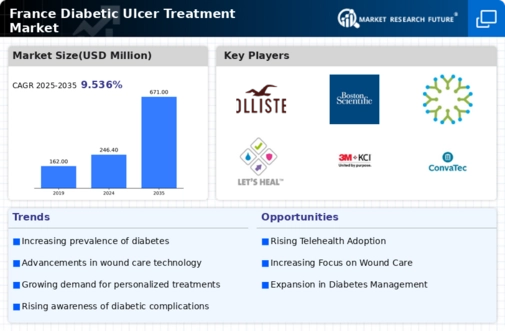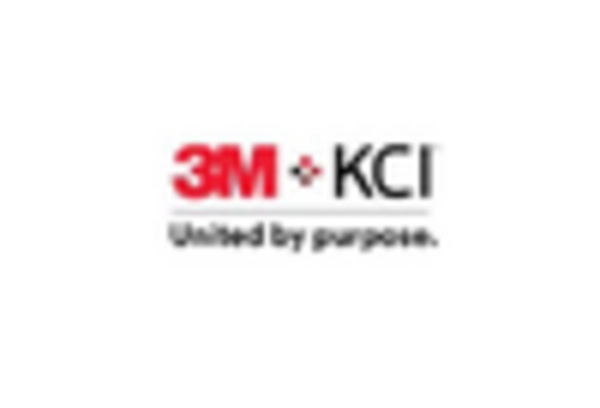Increasing Prevalence of Diabetes
The rising incidence of diabetes in France is a critical driver for the diabetic ulcer-treatment market. As of recent data, approximately 3.5 million individuals in France are diagnosed with diabetes, leading to a heightened risk of complications such as diabetic ulcers. This growing patient population necessitates effective treatment options, thereby propelling the demand for advanced wound care solutions. The diabetic ulcer-treatment market is expected to expand as healthcare providers focus on managing diabetes-related complications. Furthermore, the French healthcare system is increasingly prioritizing the allocation of resources towards diabetic care, which may further stimulate market growth. The emphasis on improving patient outcomes and reducing healthcare costs associated with complications is likely to drive innovation and investment in the diabetic ulcer-treatment market.
Government Initiatives and Funding
Government initiatives aimed at improving diabetes care are significantly influencing the diabetic ulcer-treatment market. In France, various public health campaigns and funding programs are being implemented to enhance awareness and management of diabetes-related complications. The French government has allocated substantial resources to support research and development in wound care technologies, which may lead to innovative treatment options. Additionally, reimbursement policies for advanced wound care products are evolving, making them more accessible to patients. This financial support is crucial for healthcare providers and patients alike, as it encourages the adoption of effective treatment modalities. Consequently, the diabetic ulcer-treatment market is poised for growth as these government initiatives foster a more supportive environment for innovation and patient care.
Rising Awareness and Education Programs
The increasing awareness surrounding diabetes and its complications is a crucial driver for the diabetic ulcer-treatment market. In France, educational initiatives aimed at both healthcare professionals and patients are being implemented to promote better management of diabetes and its associated risks. These programs emphasize the importance of early detection and treatment of diabetic ulcers, which can significantly improve patient outcomes. As awareness grows, patients are more likely to seek timely medical intervention, thereby increasing the demand for effective treatment options. Furthermore, healthcare providers are becoming more proactive in educating patients about self-care practices and preventive measures. This heightened focus on education is likely to contribute to the growth of the diabetic ulcer-treatment market, as it encourages a more informed patient population.
Technological Advancements in Treatment
Technological innovations play a pivotal role in shaping the diabetic ulcer-treatment market. The introduction of advanced wound care technologies, such as bioengineered skin substitutes and negative pressure wound therapy, has revolutionized treatment protocols. In France, the adoption of these technologies is on the rise, as they offer improved healing rates and reduced treatment times. The market is witnessing a shift towards more effective and patient-friendly solutions, which could enhance the overall quality of care. Moreover, the integration of digital health technologies, including mobile health applications for monitoring and managing diabetic ulcers, is gaining traction. These advancements not only improve patient engagement but also facilitate timely interventions, thereby potentially reducing the burden on healthcare systems. As a result, the diabetic ulcer-treatment market is likely to experience significant growth driven by these technological advancements.
Aging Population and Associated Health Issues
The demographic shift towards an aging population in France is a significant driver for the diabetic ulcer-treatment market. As individuals age, the prevalence of chronic conditions, including diabetes, tends to increase. This demographic trend suggests that the number of patients at risk for diabetic ulcers will likely rise, thereby intensifying the demand for effective treatment solutions. The elderly population often faces challenges related to wound healing, which necessitates specialized care and advanced treatment options. Healthcare providers are increasingly focusing on tailored approaches to manage diabetic ulcers in older adults, which may lead to the development of new products and services within the market. As a result, the diabetic ulcer-treatment market is expected to expand in response to the needs of this growing demographic.

















Leave a Comment